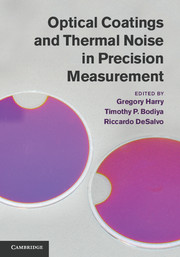Book contents
- Frontmatter
- Contents
- List of contributors
- Foreword
- Preface
- 1 Theory of thermal noise in optical mirrors
- 2 Coating technology
- 3 Compendium of thermal noises in optical mirrors
- 4 Coating thermal noise
- 5 Direct measurements of coating thermal noise
- 6 Methods of improving thermal noise
- 7 Substrate thermal noise
- 8 Cryogenics
- 9 Thermo-optic noise
- 10 Absorption and thermal issues
- 11 Optical scatter
- 12 Reflectivity and thickness optimization
- 13 Beam shaping
- 14 Gravitational wave detection
- 15 High-precision laser stabilization via optical cavities
- 16 Quantum optomechanics
- 17 Cavity quantum electrodynamics
- References
12 - Reflectivity and thickness optimization
Published online by Cambridge University Press: 05 January 2012
- Frontmatter
- Contents
- List of contributors
- Foreword
- Preface
- 1 Theory of thermal noise in optical mirrors
- 2 Coating technology
- 3 Compendium of thermal noises in optical mirrors
- 4 Coating thermal noise
- 5 Direct measurements of coating thermal noise
- 6 Methods of improving thermal noise
- 7 Substrate thermal noise
- 8 Cryogenics
- 9 Thermo-optic noise
- 10 Absorption and thermal issues
- 11 Optical scatter
- 12 Reflectivity and thickness optimization
- 13 Beam shaping
- 14 Gravitational wave detection
- 15 High-precision laser stabilization via optical cavities
- 16 Quantum optomechanics
- 17 Cavity quantum electrodynamics
- References
Summary
Introduction
This chapter is focused on design strategies for minimizing Brownian (see Chapter 4) and, more generally, thermal noises (see Chapters 3 and 9) in high-reflectivity optical coatings. It is organized as follows: in Section 12.2 we review the basic formulas needed to describe the optical properties of dielectric coatings (an ab-initio derivation of these formulas is included in the Appendix). Brownian noise formulas are the subject of Section 12.3. Section 12.4 presents the key ideas of coating thickness optimization. Thermo-optic noise issues are reviewed in Section 12.5, together with a discussion of pertinent minimization criteria. Section 12.6 contains a few comments on material characterization, and touches the important topic of glassy mixture modeling and optimization.
Coating formulas
In this section we summarize the basic coating formulas on which the subsequent analysis is based. A compact ab-initio derivation of these results is given in the Appendix.
Optical coatings are modeled as stacks of planar layers terminated on both sides by homogeneous halfspaces; the relevant geometry and notation is sketched in Figure 12.1. Layers are identified by an index i = 1, 2, …, NL. It is understood that i = 0 and i = NL + 1 correspond to the left halfspace and the substrate, respectively. It is convenient to introduce a local coordinate system (x, y, zi) for each layer, so that the internal layers i = 1, 2, …, NL correspond to -di ≤ zi ≤ 0, the left halfspace is defined by - ∞ < z0 ≤ 0, and the substrate by 0 ≤ zNL + 1 < ∞.
- Type
- Chapter
- Information
- Optical Coatings and Thermal Noise in Precision Measurement , pp. 173 - 195Publisher: Cambridge University PressPrint publication year: 2012



